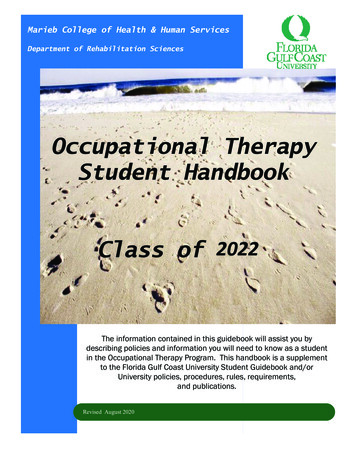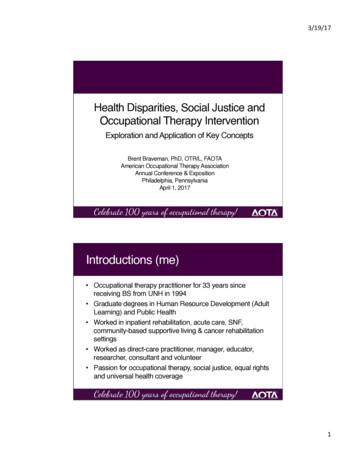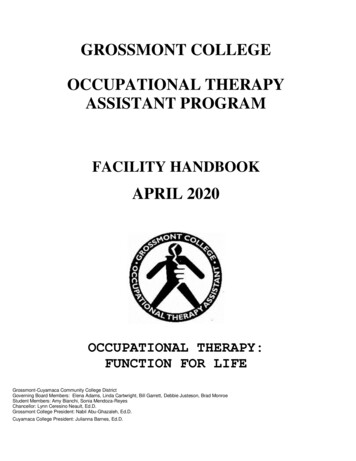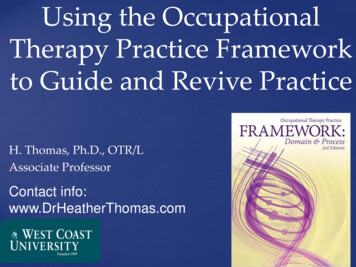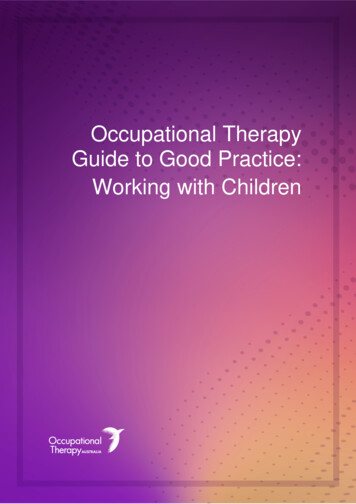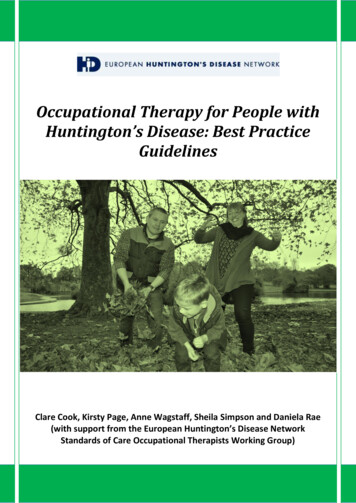
Transcription
Occupational Therapy for People with Huntington’s DiseaseBest Practice GuidelinesOccupational Therapy for People withHuntington’s Disease: Best PracticeGuidelinesClare Cook, Kirsty Page, Anne Wagstaff, Sheila Simpson and Daniela Rae(with support from the European Huntington’s Disease NetworkStandards of Care Occupational Therapists Working Group)0
Occupational Therapy for People with Huntington’s DiseaseBest Practice GuidelinesThese guidelines have been written on behalf of the EHDN Standards of Care OccupationalTherapy Working Group by:Clare Cook, Kirsty Page and Anne Wagstaff with contribution fromSheila Simpson, Daniela Rae, Louise Oakley, Stella Cannon, Adrienne Scott , Katie Moser , GunillaCroede Widsell , Jenny Werner, Eleanor Winning , Jiří Hruda, Pavla Šašinková , Paola Zinzi , HelenaSoaresEndorsed byWritten: January 2012www.euro-hd.net1
Occupational Therapy for People with Huntington’s DiseaseBest Practice Guidelines2
Occupational Therapy for People with Huntington’s DiseaseBest Practice GuidelinesTable of ContentsPart 1Part 2The process of developing the guidelinesi. Introductionii. The aim of the guidelines and target audienceiii. Ratification processiv. Comments from a caregiverBackgroundi. An overview of Huntington’s diseaseii. Aetiologyiii. When do symptoms begin?iv. Prevalencev. Diagnosisa) Genetic counselling and predictive testingb) Clinical evaluationvi. Medical Treatmentsvii. Measuring disabilityviii. Stages of Huntington’s diseaseix.The importance of occupational participationCommon impairments of people with Huntington’s disease andtheir impact on activities and participationx.Collaborative workinga) A multidisciplinary team approach and multi-agencyworkingb) Working with Family and carersc) Early and consistent interventionThe Guidelines1 Strategies for physical, cognitive and behavioural factors impacting onengagement, motivation and learning.1.1 Physical factors1.2 Cognitive factors1.2.1 Executive function1.2.2 Attention and psychomotor skill1.2.3 Memory1.3 Behavioural factors1.3.1 Depression and apathy1.3.2 Deliberate self-harm1.3.3 Anxiety1.3.4 Psychosis1.3.5 Aggression2 Optimising Activities2.1 Mobility and falls prevention2.2 Transfers and hoisting2.3 Bed mobility and sleep safety2.4 Postural management2.5 Eating and drinking2.6 Self 3
Occupational Therapy for People with Huntington’s DiseaseBest Practice Guidelines2.7 Domestic skills2.8 Fatigue3 Supporting Participation3.1 Self-efficacy3.2 Roles and relationships3.3 Work3.4 Social, recreational and leisure activities3.5 Driving3.6 Community living and outdoor mobility3.7 Advanced Decisions3.8 Power of Attorney4 End of life care4.1 24-hour postural management4.2 Manual handling and minimising risk4.3 Alternative living arrangementsAppendicesAppendix 1 Literature ReviewReferencesProduction of the guidelines363840414243464748495053545674814
Occupational Therapy for People with Huntington’s DiseaseBest Practice GuidelinesPart 1The process of developing the guidelinesi.IntroductionCare of people with Huntington’s disease varies widely between countries and in different areas inthose countries. Resources are not always available to fund and train appropriate staff. None theless, there are many Huntington’s disease management clinics worldwide. Some follow guidelinesfor care provision that they themselves have devised, others react in an ad hoc manner to peoplewith Huntington’s disease who are seen in the same clinic as those with a variety of otherneurological conditions.The European Huntington’s Disease Network (EHDN) was formed in 2003, by like-mindedclinicians and scientists who set out to provide a platform for clinicians, scientists and families towork together to find a cure for Huntington’s disease. Working groups were created to provide aforum for specialists to meet and work together in various themes. One such group was theStandards of Care working group, which has specialist groups within it such as the OccupationalTherapy working group.The standards of care working group has produced a consensus view for management ofHuntington’s disease which reflects the views of highly specialist occupational therapists in theirfield, and will enable others to provide best care for the person with Huntington’s disease andtheir family. There is little peer-reviewed evidence for our statements. The literature has beenreviewed, and it is clear that much work must be undertaken in order to clarify thepathophysiology of some of the features we see in practice, as well as the best management ofthese phenomena. We expect these guidelines to evolve as evidence emerges and this documentto be reviewed and updated accordingly.ii.The aim of the guideline and target audienceThese guidelines have been developed as a reference guide for occupational therapists workingacross Europe in a variety of health, social care and speciality settings. A systematic review wasconducted to investigate and gain consensus on the range of occupational therapy interventionsbeing used with this population and to establish their effectiveness in ameliorating the impact ofHuntington’s disease on function. Many of the recommendations in this guideline are based onhighly specialist occupational therapy opinion from the EHDN Standards of Care occupationaltherapists group which has representation from therapists across Europe and the United States ofAmerica. It aims to describe and inform contemporary best practice in occupational therapy forpeople with Huntington’s disease.5
Occupational Therapy for People with Huntington’s DiseaseBest Practice GuidelinesThe aims of these guidelines are:1. To place the person with Huntington’s disease and their family at the centre of alloccupational therapy interventions.2. To support occupational therapists in the assessment and treatment of people withHuntington’s disease.3. To provide a comprehensive over view of currently agreed best practice in Europe.iii.Ratification processThe guidelines were commissioned by the EHDN and developed as part of the Standards of Careworking group which have produced similar guidelines for physiotherapy, speech and languagetherapy, dietetics and dentistry.The two initial meetings included occupational therapists from the UK, Sweden and the USA.These meetings focussed on similarities in practice across these countries and discussion of areasto include within the guidelines. The guidelines were written by the main authors and thencirculated via e-mail to the other group members for comment and revision. A draft of theguidelines was taken to the College of Occupational Therapists in the UK for ratification.iv.Comments from a CaregiverIt is important to remember that a person with Huntington’s disease has oftenmanaged/coped/existed for many years before receiving professional help. Their carers will haveadapted their lives as best they can to deal with their difficult situation. Personalities andcapabilities vary and all react differently. A person with Huntington’s disease will have prioritiesbut not necessarily in the same order as the assessment of a professional. However, their point ofview is valid, and if acknowledged, will lead to a better working relationship. Overtime a carermay get exhausted physically, mentally and emotionally. It is important to affirm their role and tolearn from them. Sometimes they are reluctant to trust another person with their loved one, butrelationships can improve with time. The Huntington’s Disease Association (HDA) is a nationalcharity which offers help and advice to those affected by Huntington’s disease, whether peoplewith a diagnosis, people at risk, professionals or friends. Regional Care Advisors (RCA) areemployed across England and Wales, but the service varies. Some RCAs are welcomed as part ofthe local multidisciplinary team offering support through different disciplines, whilst others workvirtually alone. Current information is available from the HDA website: www.hda.org.uk(Comments from Jackie Gallop who is a carer and Regional Care Advisor for the HDA inBirmingham, UK)6
Occupational Therapy for People with Huntington’s DiseaseBest Practice GuidelinesBackgroundi.An overview of Huntington’s diseaseHuntington’s disease is a genetic, chronic neurological condition. The common features of thecondition are caused as a result of the gradual deterioration of the caudate nucleus and theputamen found within the basal ganglia.ii. AetiologyHuntington’s disease is an inherited condition caused by a mutation on chromosome 4 found ingene IT15. The protein which this gene codes is huntingtin, the building blocks of which are thetriplet repeat of cytosine, adenine and guanine (CAG). The number of CAG repeats in a normalgene ranges from 15-20. In a person with Huntington’s disease the number of CAG repeats are 36or more. Larger expansions of CAG repeats tend to result in earlier onset of the condition (Stine etal 1993) or a more rapid clinical decline (Ward et al 2006).Huntington’s disease is an autosomal dominant condition, therefore each child of an affectedperson has a 50% chance of inheriting the Huntington’s disease gene and, if they do, they willdevelop symptoms at some point in their lifetime. There is an equal incidence of the condition inmen and women. The gene does not skip a generation consequently, if the parent does not havethe gene neither will any of their children.iii.When do symptoms begin?The early symptoms of the condition may go undetected for a while and the onset is slow andgradual so it can be difficult for the individual or family member to identify exactly when thesymptoms started. Huntington’s disease can start at any age but most people develop symptomsbetween the ages of 35 and 55 years. (Quarrel, 1999).Juvenile Huntington’s disease is a rare disorder comprising of 5-12% of the cases of Huntington’sdisease. Huntington’s disease is difficult to diagnose in children due to the lack of classical featuresseen in adults. Dementia, reduced movements, rigidity and seizures often dominate the clinicalpicture in children (Jain 2005).iv.PrevalenceCurrent statistics suggest that the prevalence of Huntington’s disease is 10 people per 100 000 inUK and Europe. This means that in the UK, which has a population of approximately 55 million,there are about 5500 people with Huntington’s disease at any one time. This illustrates thatHuntington’s disease is a rare disease but if the carers and family members are also counted thiscondition affects a larger number of people (Quarrel, 1999).7
Occupational Therapy for People with Huntington’s DiseaseBest Practice Guidelinesv.Diagnosisa) Genetic counselling and predictive testingGenetic counselling is available for people with Huntington’s disease, those at risk of developingthe condition and any other family members. The aim of genetic counselling is to provideinformation about Huntington’s disease and to discuss specific family situations to enableindividuals to make informed choices about their future. Genetic counselling is provided prior toand after predictive testing to discuss the implications of knowing whether or not a person has theaffected gene.The genetic nature of Huntington’s disease results in a variety of implications and emotionalresponses within families. Family members may not be aware that Huntington’s disease is a genetic condition.Family members may not be aware that they are at risk of inheriting the disease.Where there is no discernable family history of Huntington’s disease individuals may beunaware of the nature and progression of the condition. Individuals may not want to know their Huntington’s disease status despite showing earlysymptoms of the condition.Predictive testing for Huntington’s disease has been available since 1993 but many people at riskof inheriting the condition choose not to be tested. Genetic testing can only be undertaken whenthe individual is over 18 years old and has made this decision following counselling (HDA 2010).However, genetic counselling is available to people before they reach 18. Huntington’s disease isoften not diagnosed by genetic test but through clinical evaluation once symptoms becomeproblematic.Individuals who have tested positive for the Huntington’s gene and wish to have children can havethe foetus tested to see if the gene has been inherited. Preimplantation Genetic Diagnosis (PGD) isavailable in some areas. This involves the couple having IVF treatment and the embryos beingtested for Huntington’s disease before being implanted into the woman’s womb. Only embryoswithout the Huntington’s disease mutation would be selected for implantation. Advice on foetaltesting is available from the HDA fact sheet and local genetics units.b) Clinical evaluationHuntington’s disease can be diagnosed through a combination of careful history taking andphysical testing. The clinician would complete a medical history interview often with a relative ofthe individual present. This would involve a discussion about any symptoms currentlyexperienced, when they started and any diagnosis or symptoms that a parent or other familymembers have experienced. The clinician may then complete the motor assessment the scoresfrom which could suggest the presence of Huntington’s disease.8
Occupational Therapy for People with Huntington’s DiseaseBest Practice GuidelinesTable 1: Common Signs and Symptoms of Huntington’s Disease throughout the disease stages(Rosenblatt et al. 2000, Kirkwood et al. 2001)Signs andsymptomsMotorPre-manifestEarly StageMiddle StageLate StageMild gait changesMild choreaChorea, dystoniaBradykinesiaDecreased rapidalternating movementsRigidity and spasticityRigidity and spasticityVoluntary movementabnormalitiesSevere voluntarymovement abnormalitiesDecreased co-ordinationDysarthriaDifficulty holding thingsDysphagiaBalance llectual declineGlobal dementiaIncreased musclestretch reflexesAbnormal extraocularmovementsCognitiveDifficulty with complexthinking tasksMild problems withplanning, sequencing,organising, prioritisingtasks.Memory lossPerceptual problemsLack of insight or ulty with dual tabilityIrritabilityImpulsivityAntisocial and suicidalbehaviourParanoiaDelusions or hallucinationsDeliriumMedical treatmentsCurrently there is no cure for Huntington’s disease. Symptoms tend to be treated as they occur orbecome problematic and there is a range of drugs which can be used for various symptoms. It isimportant for occupational therapists to be aware of any medications the person withHuntington’s disease is on so that they can be aware of any potential side effects that may affecttheir evaluation or intervention. Any issues relating to drug management should be addressedwith the clinician responsible for the medical management of the person.9
Occupational Therapy for People with Huntington’s DiseaseBest Practice GuidelinesTable 2: Main Drug Classes, examples and potential side effects (Quinn and Busse 2009)Class of drugAntichoreicSubclass of drugNeurolepticsandatypical gAntipsychoticAntidepressantSelective Seretonin Reuptake InhibitorsTricyclicsAntiepilepticsvii.Example medicationsRiseridone ine (Prolixin)Olanzapine (Zyprexa)Pimozide (Orap)Geodon (Ziprasidone)Clonazapam (Klonopin)Diazepam (Valium)Temazepam (Restoril)Tetrabenazine (Nitoman)Olanzapine (Zyprexa)Haloperidol (Haldol)Riperidone (Risperdal)Fluphenazine (Prolixin)Fluoxetine (Prozac)Sertraline (Zoloft)Paroxetine (Pazxil)Citalopram (Celexa)Nortriptyline (Pamelor)Amitryptiline (Elavil)Valproate (Depakote)Topiramate (Topomax)Carbamazapine (Tegretol)Potential side effectsDrowsiness, apathy, extra-pyramidal symptoms,dystonia, akathisia, hypotension, dizziness, headache,insomnia, constipation, dry mouth, weight gain,tardive dyskinesiaSedation, ataxia, apathy, withdrawal, seizures, fatigueHypotension, drowsiness, depression, gastro-intestinaldisturbance, extra-pyramidal symptomsDrowsiness, apathy, akathisia, hypotension, dizziness,headache, insomnia, constipation, dry mouth, weightgain, tardive t,restlessness, weight loss, dry mouth, alupset,restlessness, weight loss, dry mouth, anxiety,headacheNausea, vomiting, weight gain or loss, cognitiveeffects, tremor, elevated liver enzymesMeasuring disability and progression of the conditionGenerally, Huntington’s disease is a very slowly progressing condition but it can be important tomeasure change overtime and to measure the impact of treatment interventions. Centres thatare involved in the European Huntington’s Disease Network Registry project will be completing theUnified Huntington’s Disease Rating Scale (UHDRS) annually. This consists of the following subtests: Motor scale (shortened version). Cognitive tests: Stroop Test, Symbol Digit Modalities Test, and Verbal Fluency Test. Behavioural interview. Functional assessment: Total Functional Capacity, Functional Status Scale.These scales are not particularly relevant to Occupational Therapy so the therapist should selectthe most appropriate measures they have available. There is a wide range of measures used inoccupational therapy but none are specifically designed for an individual with Huntington’sdisease. Therapists need to consider what it is they want to measure and also to choose measuresthat are reliable and valid. To date, there is very little research to validate the use of outcomemeasures in people with Huntington’s disease.Measures that may be useful include:10
Occupational Therapy for People with Huntington’s DiseaseBest Practice Guidelines Assessment of Motor and Process Skills (AMPS)Model of Human Occupation Screening Tool (MoHOST)Worker Role Interview (WRI)The PRPP (Perceive, Recall, Plan, Perform) functional assessmentThe ADL TaxonomyCanadian Occupational Performance Measure (COPM)Occupational Performance History Interview version II (OPHI-II) Version 2.1 2004Dementia Care Mapping (Assessment in the late stages of the disease)viii) Stages of Huntington’s DiseaseThere have been several attempts to define the stages of progression of Huntington’s disease(Shoulson and Fahn 1979). The Total Functional Capacity Scale divides the disease into 5 stages.However, clinicians tend to describe the stages of disease progression as early, mid and late.Early disease cannot be defined as the time of diagnosis since diagnosis can be made at variabletimes. Most individuals present with early neurological and psychiatric features which may havestarted to cause difficulties at work and home, and many of these individuals are in mid stagedisease. As we reach a greater understanding of the early evolution of Huntington’s disease, thenearly stage disease will have a better definition. Recent work has shown that earlyneuropsychological deficits occur, and physical changes are visible on MRI brain scans. Certainlyfamilies report early behaviour and personality changes some years before neurological deficitscan be described. Changes may be noticeable at work (depending on the complexity of their job);it may affect driving ability and may become apparent in home tasks which require rapid taskswitching.Mid stage disease would be seen to have been reached when the affected person has to ceasework, or at least change employment to a post which is less challenging. Executive function declineand some cognitive deficit would be demonstrated. Involuntary movements may be obvious but itis most likely that individuals would still be able to care for themselves.Late stage disease occurs when employment becomes impossible, the individual is no longer ableto live independently, self-care ceases and cognitive decline is obvious. Some individuals maintainthe ability to provide limited self-care to a late stage, but the movement disorder, bothinvoluntary and voluntary creates increasing difficulties. Communication may be limited and theywill need assistance to participate in social activities.ix) The importance of occupational participation and performance in Huntington’s Disease11
Occupational Therapy for People with Huntington’s DiseaseBest Practice GuidelinesAs Huntington’s disease progresses the individual’s ability to participate in and to performoccupations (everyday) tasks becomes increasingly difficult. The type of tasks the individual valuesand wishes to perform will vary from person to person so it is important for the occupationaltherapist to spend time with the individual and their family/carers to explore these occupationsand clearly identify firstly, what they are, secondly, what the person is finding difficult about thetask now and thirdly, what resources are available to assist in occupational participation andperformance.Sullivan et al. (2001) demonstrated that mice with the Huntington’s disease gene that were placedin an enriched environment deteriorated at a slower rate than mice with the gene in a nonenriched environment. This would suggest that those people who continue to participate inactivity and deal with everyday challenges are likely to reduce the rate of functional decline. Morerecently, Trembath et al (2010) found age of onset of the illness in human subjects was associatedwith a more passive lifestyle irrespective of a patients CAG repeat length. Those with more passivelifestyles experienced onset of the illness 4.6 years earlier than those people who were moreactive. They conclude being engaged in active pastimes may slow onset of the disease.Occupational therapists will focus on a range of activities that tend to fall within the following keyareas: Self-Care – activities that enable the individual to survive and to promote and maintainhealth.Productivity - includes occupations that make a social or economic contribution or provideeconomic sustenance.Leisure – any activity entered into for the purpose of enjoyment such as socialising,creative expressions, outdoor activities and sports. (Law et al 2002).People have a basic need to participate in activity that has meaning and value to them.Occupations can serve a variety of functions in daily life: People develop and maintain function through being active. (Baum 1995) Occupations form an important part of each person’s social identity and social status, andthey influence social development. (Watson and Fourie 2004) Occupations contribute to an individual’s personal sense of identity. (Hasselkus 2002) People create meaning in their lives through what they do. (Creek 1998) Occupations promote social inclusion. (Passmore 2003) The health and well-being of the individual are influenced by what he/she does.(Hasselkuss 2002)In the early stages of Huntington’s disease it may be appropriate to use a rehabilitative approachto interventions such as using a diary, calendar, wipe board to organise and prompt tasks. In themiddle to late stages of the disease progression it is more appropriate to use a compensatoryapproach such as adapting the environment or changing routines.12
Occupational Therapy for People with Huntington’s DiseaseBest Practice GuidelinesTable 3: Highlights common impairments of people with Huntington’s disease and their impact onactivities and participationTable 3: Common impairments of people with Huntington’s disease and their impact onactivities and participationPhysical ImpairmentsChoreaBradykinesiaDystoniaReduced manual dexterity, poor coordination, reduced gripDysarthriaDysphagiaFatigueCognitive ImpairmentsBradyphreniaImpaired executive functionImpaired attentionReduced motivationDepressionAnxietyDementiaBehavioural impairmentsPsychosisChallenging behaviourProblems with activity and participationDifficulty maintaining posture andcontrolling limb movements impactingon all activities of daily living.Slowing of intentional movement.Contracting of specific muscle groupscausing balance problems and increasingrisk of falls.Difficulty with manual tasks such aseating, fastening buttons, writing,holding and operating a phone.Loss of voice clarity and decreasedintelligibility of speech.Difficulty swallowing food and drinksincreasing the risk of choking andaspiration.Reduced endurance affecting all tasks.Reduced ability to maintain posture andcomplete activities.Problems with activity and participationGeneralised slowing of thinkingprocesses.Reduced problem solving and decisionmaking skills.Reduced concentration and ability tomaintain or switch attention.Apathy, reduced interest and driveleading to social isolation.Low mood, sadness, reduced motivation.Fear, avoidance of situations.Confusion and inability to maintainsafety.Problems with activity and participationConfusion and reduced concentration.Difficulty maintaining relationships.Inability to maintain safety.13
Occupational Therapy for People with Huntington’s DiseaseBest Practice Guidelinesx) Collaborative Workinga) A multi-disciplinary team approach and multi-agency workingWhen working with people with Huntington’s disease and their families it is important to provide acohesive and multi-disciplinary service. The disease affects many different aspects of theindividual’s abilities so they will need to be assessed by appropriately trained health careprofessionals for the various difficulties they experience. Aubeeluck (2009) states,“The complex nature of HD makes it unlikely that any one professional will have all the skillsneeded to help any one individual. It is therefore of utmost importance that the service providerstake a multi-disciplinary approach to HD in order to identify the best way to assist individualpatients by taking into account their differing needs.” (p360).Whilst the person with Huntington’s disease continues to live in their own home there can be anumber of different agencies involved such as housing department, social work department, careagency workers, wheelchair services, employment services, day care centres. It can be difficult tokeep track of the people involved and their contact details. For this reason, a care co-ordinationapproach works well where one person acts as a key worker and will liaise with the otherprofessionals as necessary, advocate for the service user, and introduce new professionals to theservice user at appropriate times. In some teams the key worker or care co-ordinator will be theoccupational therapist.b) Working with family/carersAs an occupational therapist it is important to work with family, members, friends and informalcarers as well as the professionals visiting the individual. The occupational therapist should beexplaining the interventions that are being recommended to the family and carers so that they canprompt and encourage the person with Huntington’s disease between visits. The occupationaltherapist can also provide information about the disease and its progression as appropriate andrefer onto other members of the multi-disciplinary team if needed. Broaching the issue ofenvironmental adaptations with service users and carers needs to be done sensitively andthoughtfully. Occupational therapists are aware of the progression of the disease, the adaptationswhich will probably be required and the length of time it takes to get these adaptationscompleted. Referral onto the local authorities for this work can appear urgent but needs to bemanaged with sensitivity. The individual and family may not be ready to accept the changes thatthe disease will cause and the changes which may be needed to their home. Sometimes a smallerpiece of equipment will suffice in the short term but the occupational therapist may need tointroduce the idea that, for example, a bath board will not work in the long term and that thereare adaptations that can be undertaken when the family feel ready to discuss them.14
Occupational Therapy for People with Huntington’s DiseaseBest Practice Guidelinesc) Early and consistent interventionThere are a number of advantages to early intervention with people who have Huntington’sdisease: Enables the therapist to build a therapeutic relationship with the service user and family ata point when the symptoms are relatively minor. Ideally the person will be reviewed regularly and then interventions can be increasedwhen needed. Early intervention enables the use of rehabilitative strategies whilst the person retains theability to learn and adapt to difficulties. Early intervention enables the therapist to know the service user well and to build trustwhich is important as the disease progresses and more professionals become involved andthe decisions more difficult. If possible, establish and document any advanced decisions at an early stage such asmedical care (e.g. PEG), management of finances (enduring power of attorney) whilst theindividual has capacity to make these decisions. The Huntington’s Disease Association’s‘End Of Life’ fact sheets has some useful information regarding end of life issues toconsider (HDA 2009).15
Occupational Therapy for People with Huntington’s DiseaseBest Practice GuidelinesThe GuidelinesThese guidelines have been written to cover all the stages of Huntington’s disease. However, somechallenges to occupational performance will be more prevalent at specific stages of the diseasesprogression.16
Occupational Therapy for People with Huntington’s DiseaseBest Practice Guidelines1. Strategies for physical, cognitive and behavioural factors impacting on engagement,motivation and learningHuntington’s disease typically sees deterioration in the 3 areas of cognition, physical function andmood/behaviour. This section describes some of the clinical signs and symptoms observed andhow these impact on function. Suggestions of ways to overcome these problems are co
Occupational Therapy for People with Huntington's Disease Best Practice Guidelines 6 iii. Ratification process The guidelines were commissioned by the EHDN and developed as part of the Standards of Care working group which have produced similar guidelines for physiotherapy, speech and language therapy, dietetics and dentistry.
